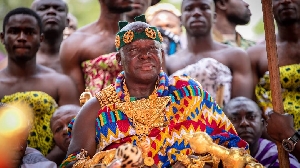Opinions of Saturday, 29 July 2023
Columnist: Kwaching Agwaazeh
The tragedy of Builsas in the Upper East Region
The Builsa District was established in 1974. The district borders are kassena Nankana East and West, Mamprugu Mogduri district in the North East Region and Sisala district in the Upper west Region.
Builsa’s have a rich culture, traditions and are hard working people. They have people in all works of life including academics, Lawyers, Engineers, top army officers, police officers top civil servants and successful business men and women.
During colonial times they contributed significantly to the army and police particularly during the Second World War. In terms of politics, Buluk (Builsa's) produced all who have risen to ministerial levels. Madam Lydia Akambodiipo is known to be one politician in the first Republic who advocated for maternity leave for women in Ghana.
The area traditionally was CPP dominated in the first republic but embraced PNDC initially in the fourth republic and now, the NDC has become the dominant force and has won nearly all parliamentary elections in the Bulsa North Constituency except in 2008 which the NPP won.
In the Builsa South since it became a district and a constituency, PNC won twice and the rest went to NDC . Despite all the individual achievement of the Builsa people, the district was now divided into Bulsa North and South which is among the most undeveloped and wretched in the Upper East Region. It is unbelievable that since independence the district has not seen a tarred road linking the north to the south. A person born at independence and in Fumbisi or Siniensi can only imagine what a tarred road looks like .
Even though the area has been linked to the national grit in the 90s by former president Rawlings, the majority of communities are still in darkness .Power supply is very unstable with frequent power outages sometimes as many as ten times in a day.
Telephone connectivity is also limited in many communities. The result of all these infrastructural deficiencies is that no investor wants to put money in there leading to a very depressed economy.
The area has rich farmlands that could be developed to produce enough food to improve incomes, nutrition and contribute to national food security but for the very bad roads and lack of investment, one cannot achieve that.
The Bulsa community bank is the only one serving the area and as you know there are many services that can not be provided by a rural bank. Many workers and pensioners have to travel to Navrongo on the dusty and rough road to access certain banking services or even to take their salaries .
The road leading to the hospital is almost a death trap as a sick person can easily die from the bumpy section and it gets worse during the rainy season. The hospital itself has no place where the dead can be laid to rest like the mortuary or a kitchen where sick people requiring special diet can be served. All patients have to buy food from outside or are served food from their homes if they come from the communities around the hospital.
Bulsa North and South together have five Senior High Schools which is impressive but they lack good facilities that can make any of them comparable to the category A schools.
Despite the fact that schools in the area have produced a few first class students, performance is generally poor and this is a consequence of poor facilities and the depressed environment students find themselves.
There is no any higher institution in Buluk . As we all know existence of a higher institution in an area also motivates students to strive to achieve so as to gain admission. It also helps in stimulating the local economy by increasing demand for certain goods and services.
Government after government have promised to do the road and even include it in their budget and yet nothing happens at the end of the day. There is a school of thought that sees the neglect of places like Builsa and other deprived districts in the north as a result of election centered culture of our political parties.
Take development to where we can maximize votes. In Accra, Ashanti, Eastern, Central and the Western Region, one can see massive development in Ashanti by the NDC despite it is not their stronghold . The idea is that if they can get 30% there they will win . Meanwhile places like Builsa which has been loyal to them have few votes and will make little impact in the struggle for votes.
Similarly NPP does not see concentration of development in the north as a priority hence roads are neglected and major infrastructure for development are not priorities there. This is the tragedy. Until our political parties see every district or constituency as important in terms of development but not number of votes they can get, the imbalance and gap between the north and the south as well as rural and urban will continue to widen just as the gap between the rich and poor.
In conclusion, the election centered political culture driven by the winner is the main cause of poverty corruption and lack of development in most rural communities particularly in the north.
Until we find a mechanism that will change that narrative, the rural poverty dilapidation and rural migration to our already over populated and stinking slams in Accra, Kumasi and mining towns as well as hazardous galamsey, street hawking, kayaye and all the negative things going on in the big cities will not only continue but will escalate .













